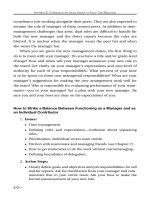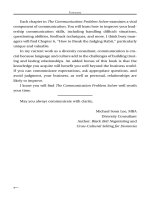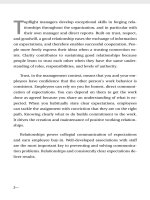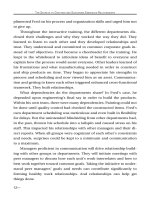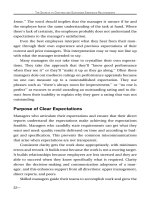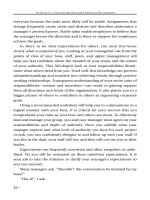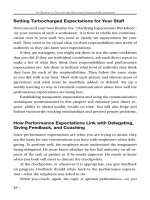The Communication Problem Solver 15 pps
Bạn đang xem bản rút gọn của tài liệu. Xem và tải ngay bản đầy đủ của tài liệu tại đây (85.33 KB, 10 trang )
H
OW TO
U
SE
Y
OUR
P
ROCESS
S
KILLS TO
P
REVENT AND
S
OLVE
C
OMMUNICATION
P
ROBLEMS
> ‘‘Violent outbursts.’’ This means he shouts profanities.
> ‘‘Hostile when questioned.’’ This means he rolls eyes, sighs, and
walks out.
> ‘‘Unprofessional behavior toward coworkers.’’ This means he
uses sarcasm or refuses to respond to them and forces his way
into conversations.
> ‘‘Not a team player.’’ This means:
• Peer engineers object to working with him.
• He seeks advice from others not involved with the project.
• He is critical of others—offers negative feedback but not posi-
tive.
3. Brainstorm a list of alternative solutions or action steps. Javier’s
list:
> Ask Human Resources’ counsel on the employee’s behavior re-
lated to shouting profanities to see if it is considered to foster a
hostile work environment and to be harassment. Ask them
whether to provide feedback from other engineers on how he is
perceived. Take any action Human Resources advises.
> Review expectations of work-schedule tasks and projects.
> Review relevant company policies with him.
> Review expectations of acceptable behavior toward peers and
manager with him.
> Discuss expectation for open dialogue and working with team
members.
> Discuss his observed behavior, contrasting that with expecta-
tions.
> Explain impact of his behavior on workflow and morale.
> Try to find root cause of his behavior.
> Offer coaching and communication training classes to help him
find proper ways to express ideas.
> Discuss consequences of continued behavior, including company
counseling process.
4. Decide preferred solution/action steps. Javier decided to start
with Human Resources to discuss the shouting of profanities. He would
122—
H
OW TO
B
REAK THE
J
UDGING
H
ABIT
then discuss the other bullet points with them and, if they agreed, follow
all action steps brainstormed in Step 3.
H. Employee Milks Assignment
1. State the problem ‘‘as is.’’ Deborah stated the original problem
as, ‘‘the employee doesn’t take the initiative. She only does what is asked
of her and ‘milks’ assignments.’’
2. Identify observable behaviors/facts—what did you see and
hear? This is what Deborah had noticed:
> The employee closes Windows (computer applications) when
manager walks by.
> The employee meets all deadlines. However, she takes double the
time needed to complete a task.
> The employee takes one day to complete tasks that should take
only a half day. Deborah previously did this job, but has not told
the employee that this task should take a half day.
> Employee does not inform Deborah when tasks are completed.
> Employee does not ask for additional assignments/projects when
she completes a task.
> Employee transferred from a subsidiary company.
Once Deborah completed this list, she realized how many assump-
tions she had made about how this new employee should perform. Deb-
orah had not set clear expectations about how long jobs should take.
Deborah needed to examine whether it was realistic to want the task
completed in only a half day. After all, the employee did meet all dead-
lines. Also, the employee is new to the organization and needs to be told
about the expectation that she come to Deborah and ask for additional
work. It may not have been an expectation where she worked before.
3. Brainstorm a list of alternative solutions or action steps. Debo-
rah’s list:
> Determine how long tasks should realistically take. Just because
Deborah did the task quickly does not mean that should be the
measure.
—123
H
OW TO
U
SE
Y
OUR
P
ROCESS
S
KILLS TO
P
REVENT AND
S
OLVE
C
OMMUNICATION
P
ROBLEMS
> Talk to employee about the length of time the project should take.
Get her side of the story. She’s a new employee so does she need
training? More structured guidelines?
> Discuss expectations that she get the task done in projected time
allotted.
> Discuss all other expectations about informing Deborah when
tasks are completed and asking for more assignments.
> Give shorter check-in times and follow-up at half day until no
longer necessary.
> Assign more work/tasks if employee needs more work.
> Discuss adding a more challenging assignment.
> Set up regular, periodic meetings/checkpoints/goals/status re-
ports/deadlines.
4. Decide preferred solution/action steps. Deborah decided to fol-
low all the action steps.
Through following the four-step process, you can replace judgments
with facts and then easily determine a path toward a solution. As you
saw in the examples, many times an employee was blamed when the
manager was the organizational obstacle. It is common for managers
following this process to realize that they may not have set clear or realis-
tic expectations. The managers may need to provide resources, including
training, in order for direct reports to meet the goals.
In the case of managing your manager, the same concept applies.
Judging is frequently a misunderstanding. Once you examine the facts,
it is often the ‘‘judge’’ who stands in the way of solving the problem.
People who work with this process quickly and honestly examine who
needs to do what in order to collaborate, achieve work objectives, and
preserve relationships.
Word Choice
Once managers follow the process to discover the root of the judgment,
they need to speak to the person they are having the problem with. Pick-
124—
H
OW TO
B
REAK THE
J
UDGING
H
ABIT
ing the right words can make the difference in whether the message is
heard. The right words can also generate enthusiasm for collaborating
and moving forward together to get the work done.
Words convey specific meaning. Managers are responsible for what
they say. Since managers exert so much influence, whether or not they
intend to, they must choose words carefully. It is important to be factual
and friendly.
Words can include or exclude people, make them feel good or rile
them up, and even assert dominance or invite collegiality. Selecting
words appropriately and positively is one of the most essential decisions
we make when we speak. The words we use can advance or impede
communication about the work and the relationships. They show re-
spect and courtesy, or the opposite. Consider the words in each of the
following pairs and the connotation of each: smile/smirk, senior man-
agement/the suits, business trip/boondoggle, famous/notorious, econo-
mizing/cheap, curious/nosy, experienced/over-the-hill, and youthful/
immature.
Poor word choice (including judgments and labels) builds walls in-
stead of bridges. Picking words ineffectively can make people feel dis-
counted and unvalued. It can create or contribute to conflict, and be
interpreted as insensitivity or lack of caring. It can lower employees’ con-
fidence and self-esteem. Words can place blame, create distrust, and
shut down communication. And the person choosing unpleasant words
can be viewed as being closed-minded.
Careful word choice can prevent people problems and establish an
atmosphere of trust and respect. Neutral words or words with positive
connotations show empathy and caring, create open communication,
and facilitate conflict resolution. Positive words make it easy for the em-
ployee to hear your feedback and to feel welcome to give you feedback.
When the relationship hits a roadblock, employees are more likely to
work through the misunderstandings if they feel that, by and large, the
manager is collegial and trustworthy, as demonstrated by his use of neu-
—125
H
OW TO
U
SE
Y
OUR
P
ROCESS
S
KILLS TO
P
REVENT AND
S
OLVE
C
OMMUNICATION
P
ROBLEMS
tral and positive language. A trustworthy manager does not use judging
terms or labels to describe anyone, up, down, or across the organization.
How to Handle Body Language Judgments
Besides using words, people can use their bodies, facial expressions, and
tone of voice to insinuate judgments and put other people down. Imag-
ine you and another speaker are up on the platform debating an issue in
front of a large audience. You are seated next to each other. Every time
it is your turn to speak, the other speaker lowers her head and shakes it
slowly left to right. She scrunches up her nose in a way that brings her
eyelids closer together rather than being open all the way. She smiles
showing her teeth. She sighs audibly. We see this behavior every day on
news panels on TV, and you may see this in your office or at a meeting.
Even though it was not this person’s turn to speak, she took the audi-
ence’s attention away from you and your words by using body language.
How do you react? Perhaps it rolls off your back and you don’t care.
Perhaps it upsets you. How do you interpret the body language? Do you
say she disagreed with your message? Do you say she was rude? She
smirked? She dismissed and discredited you?
One might have any of those opinions and they are just interpreta-
tions or judgments. They are not facts. The only facts are what we actu-
ally saw and heard happen as described in the first paragraph. The
judgments may or may not be the purpose that person had in mind
when she chose to react to your words using nonverbal communication.
Acting on body language judgments will not advance relationships or get
your message heard. You will have greater success staying with observed
facts.
You have options while you are on the platform. You can ignore the
nonverbal behavior of the other person. This is what many managers
choose to do with their direct reports. Sometimes it is appropriate, and
sometimes the behavior escalates until it bothers the audience (other
teammates).
126—
H
OW TO
B
REAK THE
J
UDGING
H
ABIT
Let’s assume you decide to address the nonverbal behavior of the
other speaker on the platform. If you choose to speak about your opin-
ion/judgment, she will probably deny it and you will end up looking
petty.
‘‘Why are you being so rude?’’ you might say.
‘‘I’m not being rude,’’ she answers.
‘‘Yes, you are,’’ you continue. ‘‘You’re smirking.’’
‘‘You’re wrong. I am not smirking. What’s the matter—are your feel-
ings hurt?’’
Notice that you are not talking about the content of the debate, but
the topic has now switched to your feelings. By now you might be plenty
angry and easily distracted from the importance of your original mes-
sage. You will not be winning the support of your audience. You will look
like you do not exhibit grace under pressure. You may think people see
you as a ‘‘victim’’ who can’t handle the communication challenge.
Another option is to address the behavior using only observable
facts. This might get some information about why the person is using
the body language and get an honest discussion going. Perhaps it will
get you both back on track and focused about the work at hand.
‘‘I noticed you shook your head ‘No’ and smiled when I made my
point.’’
‘‘Did I?’’
You use neutral, open body language and silently wait for her to con-
tinue.
‘‘Well, what you said about X was totally ridiculous,’’ she says.
You ignore her tone of voice and concentrate only on the words she
spoke. ‘‘What exactly did you find ridiculous?’’ you ask.
‘‘I totally disagree with your comment about . . .’’
‘‘I’ll present my research in a moment,’’ you say. ‘‘But first let’s talk
about why you disagree.’’
Now you are back to debating ideas because you have facilitated a
nonemotional discussion based on observable behaviors rather than
—127
H
OW TO
U
SE
Y
OUR
P
ROCESS
S
KILLS TO
P
REVENT AND
S
OLVE
C
OMMUNICATION
P
ROBLEMS
being judgmental or letting the other person’s judgments control your
behavior. You have stayed on message and can get results.
Summary
Judgments and labeling can escalate problems with people and thus
block productivity and quality. Judging—even done jokingly—damages
relationships because there is no clear communication about the mean-
ing of the label or what to do to change behavior.
When you use the process for untangling and solving people prob-
lems, suddenly ‘‘people problems’’ become factual business issues that
are unemotional. Once you are able to unravel them and get to the bot-
tom of the situation, you are able to analyze and work it out much more
easily. The emotion gets washed out and the problem becomes an arm’s-
length issue. You can confidently handle these problems using process
skills, just as you would handle any other of your managerial responsibil-
ities.
Stating facts and observable behavior is a very important skill to use
in all work discussions. Whether delegating, following up on progress,
giving feedback, or coaching, it is imperative to untangle any judgments
and speak with words both parties can agree on—facts.
Chapter 7 addresses many common management communication
problems. Just as in this chapter, the facts of these problems also need
to be analyzed so that solutions/action steps can be determined.
128—
CHAPTER
7
Common People Problems—
A Handy Reference
Chapter 6 offered a process for untangling judgments so that people
problems could be analyzed and handled as business issues. Besides
judging or labeling people, there are other common people problems
that are prickly for managers. Several of the most common ones are dis-
cussed in this chapter, using real-world examples. A simple process is
offered here to help you handle these types of problems. If you develop
this simple skill for solving people problems, you will form a habit that
will help you invigorate relationships and work collaboratively. This
habit will help you achieve work results through others.
People problems can be solved, and it is the manager’s job to handle
these problems. Sometimes what seems at first to be a ‘‘people problem’’
is an opportunity to explore differing points of view. Multiple viewpoints
can contribute to innovative and better products and services. Having
different perspectives can help the team develop conflict-resolution
skills, which strengthens the team. When coworkers are able to honestly
state their views on the work, they develop trust in the working relation-
ship and confidence that misunderstandings can and will be worked out.
Defining People Problems
‘‘People problems’’ is a shortcut term many use to describe unresolved
interpersonal conflicts, as opposed to mechanical, technical, or other
—129
H
OW TO
U
SE
Y
OUR
P
ROCESS
S
KILLS TO
P
REVENT AND
S
OLVE
C
OMMUNICATION
P
ROBLEMS
work problems. Sometimes managers who are quick to resolve other
work-related problems procrastinate about resolving work problems
that they perceive are related to people. A manager might not like a di-
rect report, or might judge him, as discussed in Chapter 6. Or a problem
might exist between coworkers who report to the manager.
Sometimes there are elements of emotion involved and the manager
isn’t sure how to properly tackle the issue. Perhaps the manager wants
to avoid confrontation or an unpleasant conversation. Or the problem is
with the manager’s boss or peer. The manager isn’t sure how to ap-
proach a person she perceives as having equal or more organizational
power because the stakes are higher. Oftentimes the manager just plain
does not know how to define ‘‘people problems’’ as logical work per-
formance issues to be solved by a rational process.
Conflicts can be about differences in opinion, traits, or beliefs.
Sometimes a person thinks he is right and refuses to explore the other
person’s viewpoint. On the other hand, a person may lack confidence in
his own ability or opinion or lack the capacity to defend his position
without escalating conflict. Sometimes people fear looking bad or losing
their jobs or reputations, so they choose not to be honest communica-
tors. Others overlook the value and necessity of developing strong work-
ing relationships.
Causes of Problems Among People
Misunderstandings and other communication problems among people
at work are probably as old as work itself. How could it be otherwise?
People have backgrounds and viewpoints that differ from those of oth-
ers. Because of this, it is difficult to articulate meaning in a nonemotional
way that others can understand dispassionately. This section will exam-
ine many factors that can cause communication problems.
Too Much Togetherness
The old adage ‘‘familiarity breeds contempt’’ means that it is quite com-
mon for people who are together a lot—at home, at play, or at work—to
130—
C
OMMON
P
EOPLE
P
ROBLEMS
—A H
ANDY
R
EFERENCE
become upset with each other. When people work closely together, there
are bound to be misunderstandings and communication problems
among them. Too much in-person contact might just be annoying, espe-
cially if a coworker has a habit we don’t like. It is to be expected that
people may become impatient with one another if they see each other
frequently. Or they may take each other for granted and not make
enough effort at communicating properly. They may misinterpret a mes-
sage based on what it meant in the past when they worked on something
similar.
Didier’s cubicle is next to Pierre’s. They have worked on projects
together for over three years. Pierre has been the team leader and, from
Didier’s perspective, has imposed his way of approaching the project
every time, supposedly because of time constraints. Today, Pierre asks
Didier, ‘‘What are some alternative ways to approach this project? What
do you think we should do here?’’ Instead of answering the question
directly, Didier might use his past experience with Pierre and be cau-
tious. Will he waste his energy if he spends time analyzing the best ap-
proach and then Pierre does what he wants anyway? Has Pierre changed
his leadership approach and does he truly want Didier’s opinion?
Not Enough In-Person Contact
The opposite of too much togetherness is not seeing each other in per-
son enough. Not being together in the same location contributes to
many communication problems. Today many managers have direct re-
ports who work at remote locations—at home, at a coffee shop, or at
another office location. Other office locations can be in other cities or in
other countries—even on other continents. These remote workers are
connected to coworkers via the Internet. They work virtually, meaning
technology links them together regardless of the geographic location or
the time zone. Virtual teams collaborate and can be in constant contact
worldwide.
If Ron works in Toronto and his direct reports work in Tokyo and
—131


